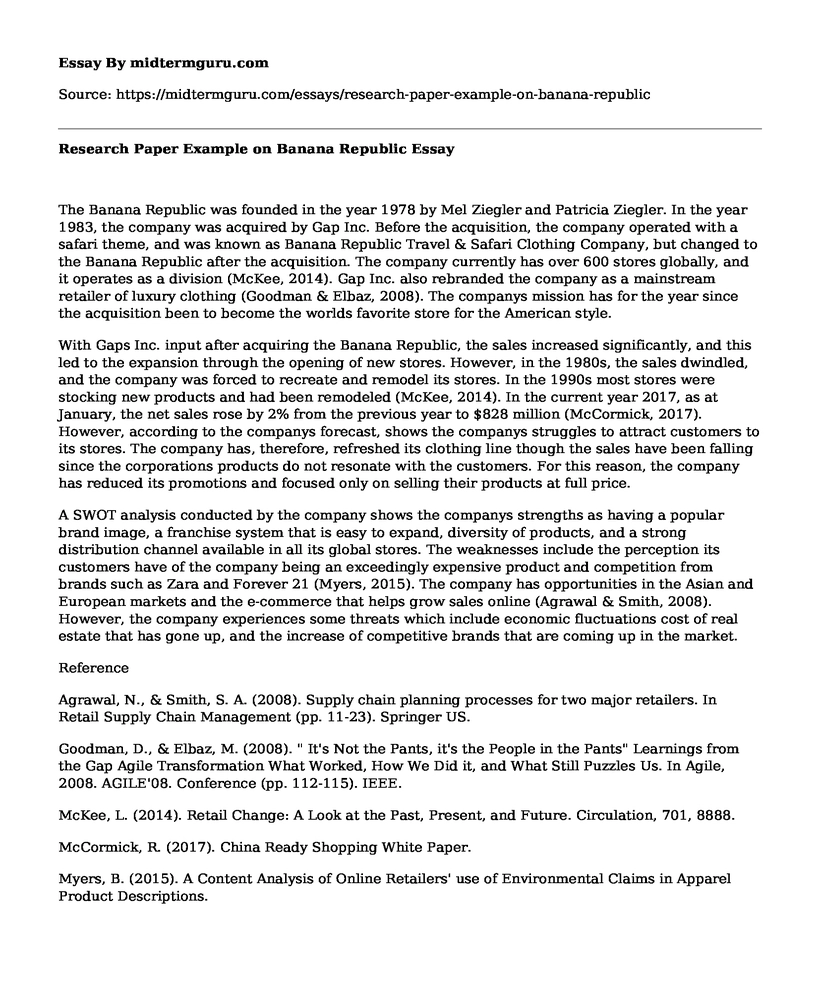The Banana Republic was founded in the year 1978 by Mel Ziegler and Patricia Ziegler. In the year 1983, the company was acquired by Gap Inc. Before the acquisition, the company operated with a safari theme, and was known as Banana Republic Travel & Safari Clothing Company, but changed to the Banana Republic after the acquisition. The company currently has over 600 stores globally, and it operates as a division (McKee, 2014). Gap Inc. also rebranded the company as a mainstream retailer of luxury clothing (Goodman & Elbaz, 2008). The companys mission has for the year since the acquisition been to become the worlds favorite store for the American style.
With Gaps Inc. input after acquiring the Banana Republic, the sales increased significantly, and this led to the expansion through the opening of new stores. However, in the 1980s, the sales dwindled, and the company was forced to recreate and remodel its stores. In the 1990s most stores were stocking new products and had been remodeled (McKee, 2014). In the current year 2017, as at January, the net sales rose by 2% from the previous year to $828 million (McCormick, 2017). However, according to the companys forecast, shows the companys struggles to attract customers to its stores. The company has, therefore, refreshed its clothing line though the sales have been falling since the corporations products do not resonate with the customers. For this reason, the company has reduced its promotions and focused only on selling their products at full price.
A SWOT analysis conducted by the company shows the companys strengths as having a popular brand image, a franchise system that is easy to expand, diversity of products, and a strong distribution channel available in all its global stores. The weaknesses include the perception its customers have of the company being an exceedingly expensive product and competition from brands such as Zara and Forever 21 (Myers, 2015). The company has opportunities in the Asian and European markets and the e-commerce that helps grow sales online (Agrawal & Smith, 2008). However, the company experiences some threats which include economic fluctuations cost of real estate that has gone up, and the increase of competitive brands that are coming up in the market.
Reference
Agrawal, N., & Smith, S. A. (2008). Supply chain planning processes for two major retailers. In Retail Supply Chain Management (pp. 11-23). Springer US.
Goodman, D., & Elbaz, M. (2008). " It's Not the Pants, it's the People in the Pants" Learnings from the Gap Agile Transformation What Worked, How We Did it, and What Still Puzzles Us. In Agile, 2008. AGILE'08. Conference (pp. 112-115). IEEE.
McKee, L. (2014). Retail Change: A Look at the Past, Present, and Future. Circulation, 701, 8888.
McCormick, R. (2017). China Ready Shopping White Paper.
Myers, B. (2015). A Content Analysis of Online Retailers' use of Environmental Claims in Apparel Product Descriptions.
Cite this page
Research Paper Example on Banana Republic. (2021, Jul 05). Retrieved from https://midtermguru.com/essays/research-paper-example-on-banana-republic
If you are the original author of this essay and no longer wish to have it published on the midtermguru.com website, please click below to request its removal:
- Transnational Corporations Sales and Acorporate Social Responsibilities
- The Maritime Law and The Hague-Visby Rules - Paper Example
- Comparison of Gross Domestic Product - Economics Paper Example
- Research Paper on United States-China Trade War
- How Does Germany Conduct International Business? - Paper Example
- China-USA Trade War Case Analysis
- U.S. - China Bilateral Relations: Trade Tensions Due to Market Economy Transition - Research Paper







